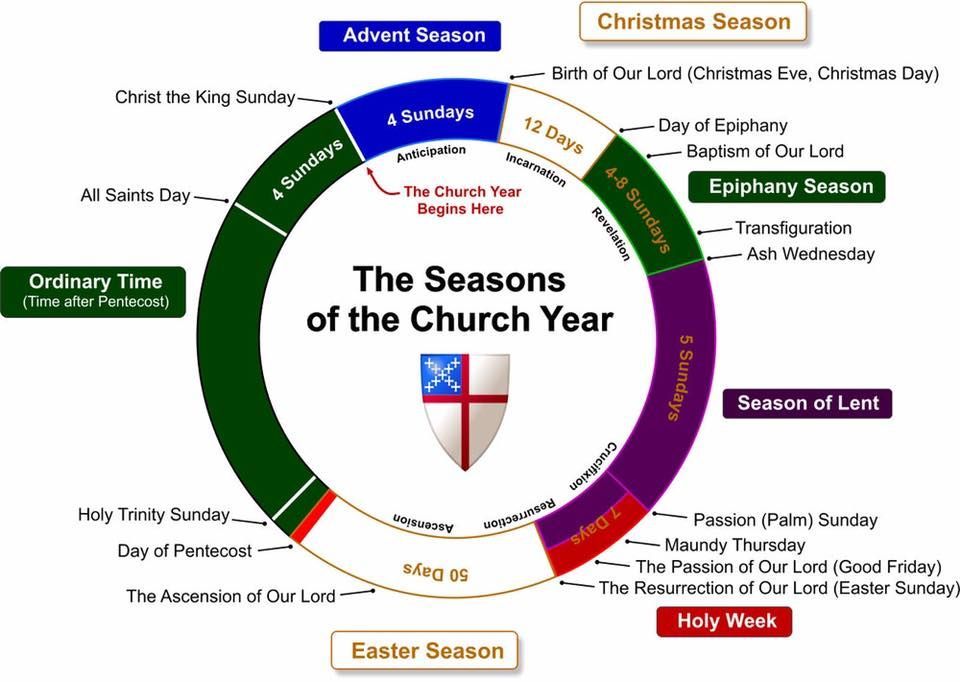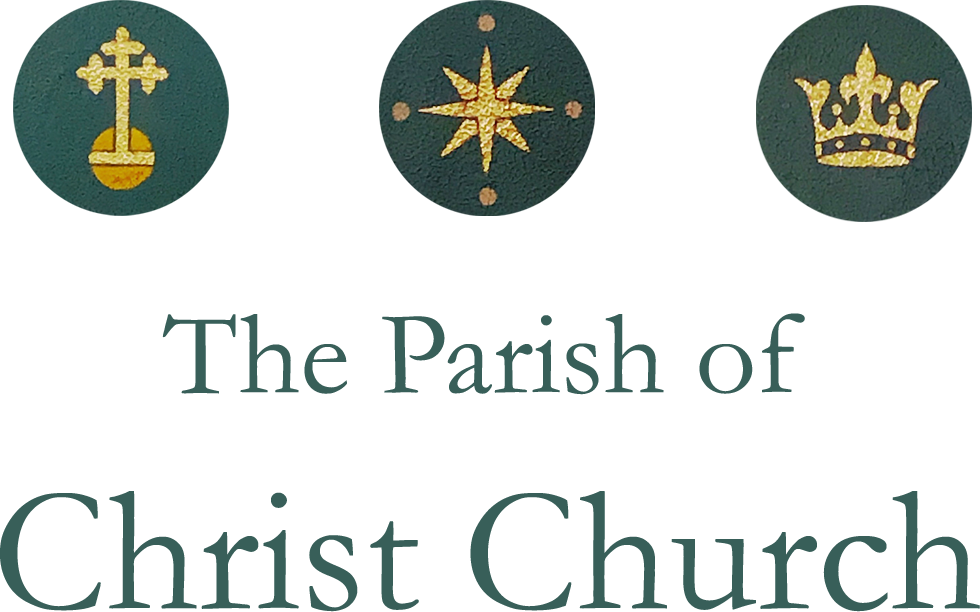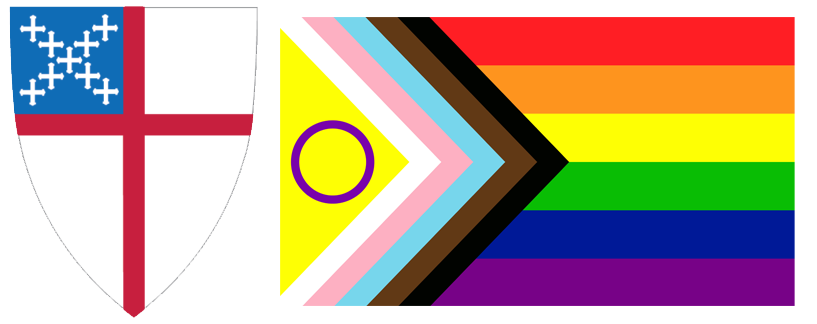New to our Worship?
What to expect when you join us for worship
Worship at Christ Church is joyful -- and predictable! Sunday services are based on the Book of Common Prayer used by Episcopal Churches throughout the United States and very close to what is used in Episcopal/Anglican churches throughout the world. People coming from Roman Catholic or other similar liturgical backgrounds find our worship very familiar. Others who come from more Protestant backgrounds learn to love the beauty and dignity (some might say "formality") of our worship. We try to strike just the right balance between beauty, reverence, and ease of participation for all. Above all, everyone is a participant -- not a mere spectator -- engaging body, mind, and spirit!
A Guide to the Service
We recognize that many parishioners or visitors to our church come from different faith backgrounds, and we want to welcome everyone. The Episcopal language can be formal and therefore can feel like a barrier to understanding what is going on in the service. Below are some excerpts from An Episcopal Dictionary of the Church: A User-Friendly Reference for Episcopalians (Don S. Armentrout and Robert Slocum, Church Publishing Inc.) We hope that this page provides helpful information for all who enter our doors either virtually or in person. Please feel free to get in touch with questions by emailing our Rector:
mhodges@christchurchandover.org
We are a Sacramental Church
In the Episcopal Church, sacraments are “outward and visible signs of inward and spiritual grace.” (The Book of Common Prayer, p. 857) Holy Baptism and the Eucharist (or Holy Communion) are the two great sacraments given by Christ to his Church. Baptism and Eucharist are the primary Sacraments in the Episcopal Church. Other sacramental rites include: Confirmation, Marriage, Ordination, Reconciliation, and Anointing for Healing.
We are a Liturgical Church
"Liturgy" is the church’s public worship of God. Liturgy includes actions, words, symbols, rituals, scripture, prayer, and music; together they comprise our worship service. Our liturgy or service expresses the church’s identity and mission, including the unity of its members in Christ and its concern for the needs of the world. It also expresses the spiritual reality of God’s presence in our lives. It manifests our love of God. The liturgy varies according to the season of the church year
(see below).
The Eucharist (or Communion) ... our main service on Sundays
The Eucharist is the principal act of Christian worship and is also known as Holy Communion. It is considered the visible sign of Christ’s body and blood. The Eucharist is based on the Last Supper where Jesus shared bread and wine with his disciples. He identified the bread as his body and wine as his blood and explained that they are symbols of the new life he came to bring us. The term “Eucharist” comes from the Greek work for “thanksgiving.”
Communion is the act where we are “in union” with one another in Christ in the sacrament of His Body (the bread) and Blood (the wine). Sacraments are symbols that teach us about God. They are participatory, communal, and efficacious – that is, if we partake in them over time, with holy intention, they shape our souls. We believe that the sacrament of Communion is God’s gift to be shared freely with anyone who comes forward to receive it. EVERYONE is welcome at God’s table.
Having said that, If you are new to our parish and do not wish to take Communion, you may stay seated. We hope you will join us soon! Children may also abstain from Communion but may receive a blessing instead – once at the altar, children (or anyone not wishing to partake in Communion) may cross their arms over their chest in an X. The celebrant will then say a blessing before moving on to the next parishioner.
Here are some terms you will hear or read as part of our Sunday morning service that you may find helpful....
Collect
A brief liturgical prayer that varies in content according to the day and season in the church year. It’s typically comprised of a single sentence that “collects” the themes appropriate to the day.
Lectionary
Since 2006, the Episcopal Church has followed the
Revised Common Lectionary. This is a lightly revised schedule of readings that you find in the back of your Book of Common Prayer. We also read a lesson from the Hebrew scriptures (Old Testament), then a Psalm (see below), then a New Testament lesson from the section after the four gospels.
Psalm
A psalm is a hymn of the Old Testament. They are ancient poetic expressions of faith. Many of them were in use before 500 BC! They were traditionally sung. During our 8:00 a.m. service, the psalm is spoken. The psalm is sung during our 10:00 a.m. service. In the summer months, our full choir is not in session at our single 9:00 a.m. service, so the psalm is spoken.
Gospel
The word “gospel” comes from the Greek word for “good news”. The New Testament contains four gospels – Matthew, Mark, Luke, and John – each of which tells the story of Jesus’ life, ministry, and teachings from a different perspective. Our weekly gospel reading comes from one of these four books of the Bible. The gospel is read only by the celebrant (priest). It is the high point of all the scripture that is read during the service.
Sermon
The purpose of the sermon is to discuss the Word of God heard in the readings for the day. The sermon teaches us about God’s message in its historical context, personalized in a contemporary way so parishioners hear and feel its inspirational message for their lives.
Nicene Creed
The Nicene Creed was written by clergy in the 4th century AD to gather and define the common beliefs of the many Christian sects existing at the time. It was an attempt to provide unity. While the Apostles Creed (which we speak at baptisms) is a statement of personal belief, the Nicene Creed is a statement of what we as a church believe and communal expression of faith.
Catholic
The use of this word in the Nicene Creed means “general” or “universal”. It emphasizes our inclusion of all people, from ancient times to the present.
Apostolic
The use of this word in the Nicene Creed reflects our belief that the church continues the faith and work of the early Christian apostles.
Prayers of the People
This form of prayer-for-others has been in existence since the 2nd century AD. This prayer addresses six categories of those in need: the church, the world, the nation, the community, the suffering, and the dead. It serves to remind us that we are joined in Christ’s love to those in need: they are every bit as present with us as those sitting with us in the pews.
Lectors and Intercessors
At Christ Church, the lector/intercessor reads the lessons (generally in each service there are two readings from different books in the Bible, plus a psalm, as well as the Prayers of the People).
The Peace
When we greet one another in the name of the Lord, we are recalling an ancient Christian practice. (The book of Romans tells us to “Greet one another with a holy kiss”.) We do not take this literally! It is fine to say, “Peace” and “Good Morning” and to shake hands if you are comfortable doing so – or just give a warm greeting and a smile to parishioners around you. This greeting of The Peace is a sign of Christian love and relationship. In the service, it is significant that The Peace follows the confession of sin and absolution. Our brokenness, sin, and shame isolate us from one another, but after we have confessed and received absolution, it makes sense to celebrate our reintegration. Passing the peace of God is how we celebrate.
Offering
The offering consists of the procession of the elements (bread and wine) for communion. This act recalls the actions of the early church in which individual members of the church provided the bread and wine from their own homes for the eucharistic feast. At this time in the service, we collect monetary gifts to support the ministry of the church. There are various ways to give financially to the church, so there is no expectation or judgment on those who choose not to participate in the weekly offering.
Doxology
Words of glory or praise to God. We sing this praise when the offerings are presented to God.
The Great Thanksgiving
This is the central prayer of the Eucharist. In it, the priest gives thanks for the bread and wine, and also for creation (giving thanks for our lives, our souls, the earth and all its inhabitants), redemption (giving thanks that Jesus offered his life on the cross in order that our sins would be forgiven and that we would no longer suffer alienation from God), and sanctification (giving thanks for the process of God working within each one of us to bring us into a more full, rich, and holy life).
Sanctus
Comes from the Latin for “holy”, and is a hymn of adoration and praise.
New Covenant
This is a term with deep and complex meaning. Simply put, it describes the new relationship or agreement we have with God that was given by Jesus Christ. At the heart of this agreement is love: Through his loving sacrifice on the cross, Jesus agrees to bring us into the kingdom of God and give us a full life. In return, we agree to follow him in loving God and one another. The New Covenant describes a spirituality that eliminates boundaries between people and between God and people. It promises a relationship with God where compassion and mercy are more important than rules, laws, and judgment.
Breaking of the Bread
During Communion, the priest breaks the consecrated bread/wafer prior to distributing it. This act recalls that Christ’s body was broken for us and for our salvation.
Dismissal
The words spoken by the priest or lay worship leader at the very end of the service. The dismissal is the “sending out” of the congregation to embody Christ’s love and teachings in the world. It helps to remind us that being a Christian means living our beliefs beyond Sunday.
Worship Resources
Our worship is aided by our printed Sunday leaflet, distributed by the ushers (or available on the back table), or by the books in the pews. The Red book is The Book of Common Prayer, the official book of worship of the Episcopal Church. Although it has been modified over the centuries, this book has been in use since 1549. Its purpose is to provide liturgies, prayers, and instructions so Episcopalians and Anglicans the world over may share in and be united by a common form of worship. The elements of our worship in Sunday’s service leaflet come from The Book of Common Prayer.
At present, we provide almost all of the words of the service for that particular Sunday in your service leaflet. You are, of course, at liberty to use the Book of Common Prayer if that is your preference.
The Blue book is The Hymnal 1982, the official book of hymns of the Episcopal Church. It has been in existence since 1789 but we use the modified 1982 edition.
The Green book is a later supplement to The Hymnal 1982 called
Wonder, Love & Praise.
Seasons of the Church Year
The Church Year consists of different cycles: Easter (resurrection) and Christmas (incarnation). The resurrection cycle includes Lent through the 50 days following Easter. The incarnation cycle includes Advent through the Epiphany. The rest of the time is “ordinary” or “numbered” time when we learn about the life and teachings of Jesus. Beginning with Advent (late Nov. or early Dec.) the church year is: Advent – Christmas- Epiphany- Lent- Holy Week & Easter- 50 days of Easter – Pentecost - Ordinary time (late spring through fall). Then Advent begins again.

Colors of the Church Year
You will notice different colors decorating the altar and the robes (or vestments) of the celebrant (priest) at different times of the year.
- We have recently begun using blue as the color for Advent to emphasize hope, anticipation, preparation and introspection. The deep shade of blue represents the color of the sky just before dawn. Blue is also the traditional color of Jesus' humanity, and the color of his mother, the Blessed Virgin Mary.
- Purple is a solemn color symbolizing waiting, reflection, and penitence which is used during Lent.
- White signifies the purity and light of Christ as well as his resurrection. White is used on Christmas, and the 12 days of Christmas, as well as the entire season of Easter -- the 50 days, beginning on Easter Sunday. It is also used for other major feast days of the Church, such as the feast of the Epiphany, Trinity Sunday, and All Saints Sunday. White is also the color used for baptisms, weddings, and funerals, with each of these services celebrating the resurrected life we have in Christ.
- Red is symbolic of sacrifice, martyrdom and blood as well as fire. Red is used during Holy Week and for the feast of Pentecost, when we give thanks for the gift of the Holy Spirit who descended on the earliest disciples like tongues of fire.. Red is also the official color of the Holy Order of Bishops, and is used for all Episcopal offices (consecrations, ordinations, and confirmations) and visitations.
- Green is used during the ordinary time after the Epiphany and also after Pentecost. Green is symbolic of growth and life. During ordinary time after Epiphany and after Pentecost, we strive to learn and grow through our lessons each Sunday.
About Us
The Vision of Christ Church to be an open, welcoming Episcopal congregation living the Gospel of Jesus Christ....

